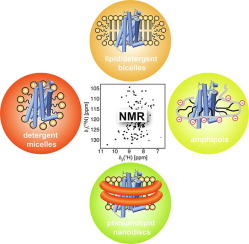当前位置:
X-MOL 学术
›
Prog. Nucl. Magn. Reson. Spectrosc.
›
论文详情
Our official English website, www.x-mol.net, welcomes your feedback! (Note: you will need to create a separate account there.)
Beyond detergent micelles: the advantages and applications of non-micellar and lipid-based membrane mimetics for solution-state NMR
Progress in Nuclear Magnetic Resonance Spectroscopy ( IF 6.1 ) Pub Date : 2019-10-01 , DOI: 10.1016/j.pnmrs.2019.08.001 Kai Klöpfer 1 , Franz Hagn 1
Progress in Nuclear Magnetic Resonance Spectroscopy ( IF 6.1 ) Pub Date : 2019-10-01 , DOI: 10.1016/j.pnmrs.2019.08.001 Kai Klöpfer 1 , Franz Hagn 1
Affiliation

|
Membrane proteins are important players in signal transduction and the exchange of metabolites within or between cells. Thus, this protein class is the target of around 60 % of currently marketed drugs, emphasizing their essential biological role. Besides functional assays, structural and dynamical investigations on this protein class are crucial to fully understanding their functionality. Even though X-ray crystallography and electron microscopy are the main methods to determine structures of membrane proteins and their complexes, NMR spectroscopy can contribute essential information on systems that (a) do not crystallize and (b) are too small for EM. Furthermore, NMR is a versatile tool for monitoring functional dynamics of biomolecules at various time scales. A crucial aspect of such studies is the use of a membrane mimetic that resembles a native environment and thus enables the extraction of functional insights. In recent decades, the membrane protein NMR community has moved from rather harsh detergents to membrane systems having more native-like properties. In particular, most recently phospholipid nanodiscs have been developed and optimized mainly for solution-state NMR but are now also being used for solid-state NMR spectroscopy. Nanodiscs consist of a patch of a planar lipid bilayer that is encircled by different (bio-)polymers to form particles of defined and tunable size. In this review, we provide an overview of available membrane mimetics, including nanodiscs, amphipols and bicelles, that are suitable for high-resolution NMR spectroscopy and describe how these advanced membrane mimetics can facilitate NMR studies on the structure and dynamics of membrane proteins. Since the stability of membrane proteins depends critically on the chosen membrane mimetic, we emphasize the importance of a suitable system that is not necessarily developed for solution-state NMR applications and hence requires optimization for each membrane protein. However, lipid-based membrane mimetics offer the possibility of performing NMR experiments at elevated temperatures and studying ligand and partner protein complexes as well as their functional dynamics in a realistic membrane environment. In order to be able to make an informed decision during the selection of a suitable membrane system, we provide a detailed overview of the available options for various membrane protein classes and thereby facilitate this often-difficult selection process for a broad range of desired NMR applications.
中文翻译:

超越洗涤剂胶束:非胶束和基于脂质的膜模拟物在溶液态核磁共振中的优势和应用
膜蛋白是信号转导和细胞内或细胞间代谢物交换的重要参与者。因此,这种蛋白质类别是目前市场上大约 60% 药物的目标,强调了它们的基本生物学作用。除了功能分析外,对该蛋白质类别的结构和动力学研究对于充分了解其功能至关重要。尽管 X 射线晶体学和电子显微镜是确定膜蛋白及其复合物结构的主要方法,但 NMR 光谱可以提供有关 (a) 不结晶和 (b) 对于 EM 来说太小的系统的基本信息。此外,核磁共振是一种多功能工具,用于在不同时间尺度上监测生物分子的功能动力学。此类研究的一个关键方面是使用类似于原生环境的膜模拟物,从而能够提取功能见解。近几十年来,膜蛋白 NMR 社区已经从相当苛刻的去污剂转变为具有更天然特性的膜系统。特别是,最近的磷脂纳米盘主要针对溶液态核磁共振进行开发和优化,但现在也用于固态核磁共振光谱。纳米圆盘由一块平面脂质双层组成,该双层脂质双层被不同的(生物)聚合物包围,以形成具有确定和可调尺寸的颗粒。在这篇综述中,我们概述了可用的膜模拟物,包括纳米圆盘、amphipols 和 bicelles,适用于高分辨率 NMR 光谱并描述这些先进的膜模拟物如何促进对膜蛋白结构和动力学的 NMR 研究。由于膜蛋白的稳定性关键取决于所选的膜模拟物,我们强调了一个合适的系统的重要性,该系统不一定是为溶液态 NMR 应用开发的,因此需要对每种膜蛋白进行优化。然而,基于脂质的膜模拟物提供了在高温下进行 NMR 实验和研究配体和伴侣蛋白复合物及其在现实膜环境中的功能动力学的可能性。为了能够在选择合适的膜系统期间做出明智的决定,
更新日期:2019-10-01
中文翻译:

超越洗涤剂胶束:非胶束和基于脂质的膜模拟物在溶液态核磁共振中的优势和应用
膜蛋白是信号转导和细胞内或细胞间代谢物交换的重要参与者。因此,这种蛋白质类别是目前市场上大约 60% 药物的目标,强调了它们的基本生物学作用。除了功能分析外,对该蛋白质类别的结构和动力学研究对于充分了解其功能至关重要。尽管 X 射线晶体学和电子显微镜是确定膜蛋白及其复合物结构的主要方法,但 NMR 光谱可以提供有关 (a) 不结晶和 (b) 对于 EM 来说太小的系统的基本信息。此外,核磁共振是一种多功能工具,用于在不同时间尺度上监测生物分子的功能动力学。此类研究的一个关键方面是使用类似于原生环境的膜模拟物,从而能够提取功能见解。近几十年来,膜蛋白 NMR 社区已经从相当苛刻的去污剂转变为具有更天然特性的膜系统。特别是,最近的磷脂纳米盘主要针对溶液态核磁共振进行开发和优化,但现在也用于固态核磁共振光谱。纳米圆盘由一块平面脂质双层组成,该双层脂质双层被不同的(生物)聚合物包围,以形成具有确定和可调尺寸的颗粒。在这篇综述中,我们概述了可用的膜模拟物,包括纳米圆盘、amphipols 和 bicelles,适用于高分辨率 NMR 光谱并描述这些先进的膜模拟物如何促进对膜蛋白结构和动力学的 NMR 研究。由于膜蛋白的稳定性关键取决于所选的膜模拟物,我们强调了一个合适的系统的重要性,该系统不一定是为溶液态 NMR 应用开发的,因此需要对每种膜蛋白进行优化。然而,基于脂质的膜模拟物提供了在高温下进行 NMR 实验和研究配体和伴侣蛋白复合物及其在现实膜环境中的功能动力学的可能性。为了能够在选择合适的膜系统期间做出明智的决定,



























 京公网安备 11010802027423号
京公网安备 11010802027423号